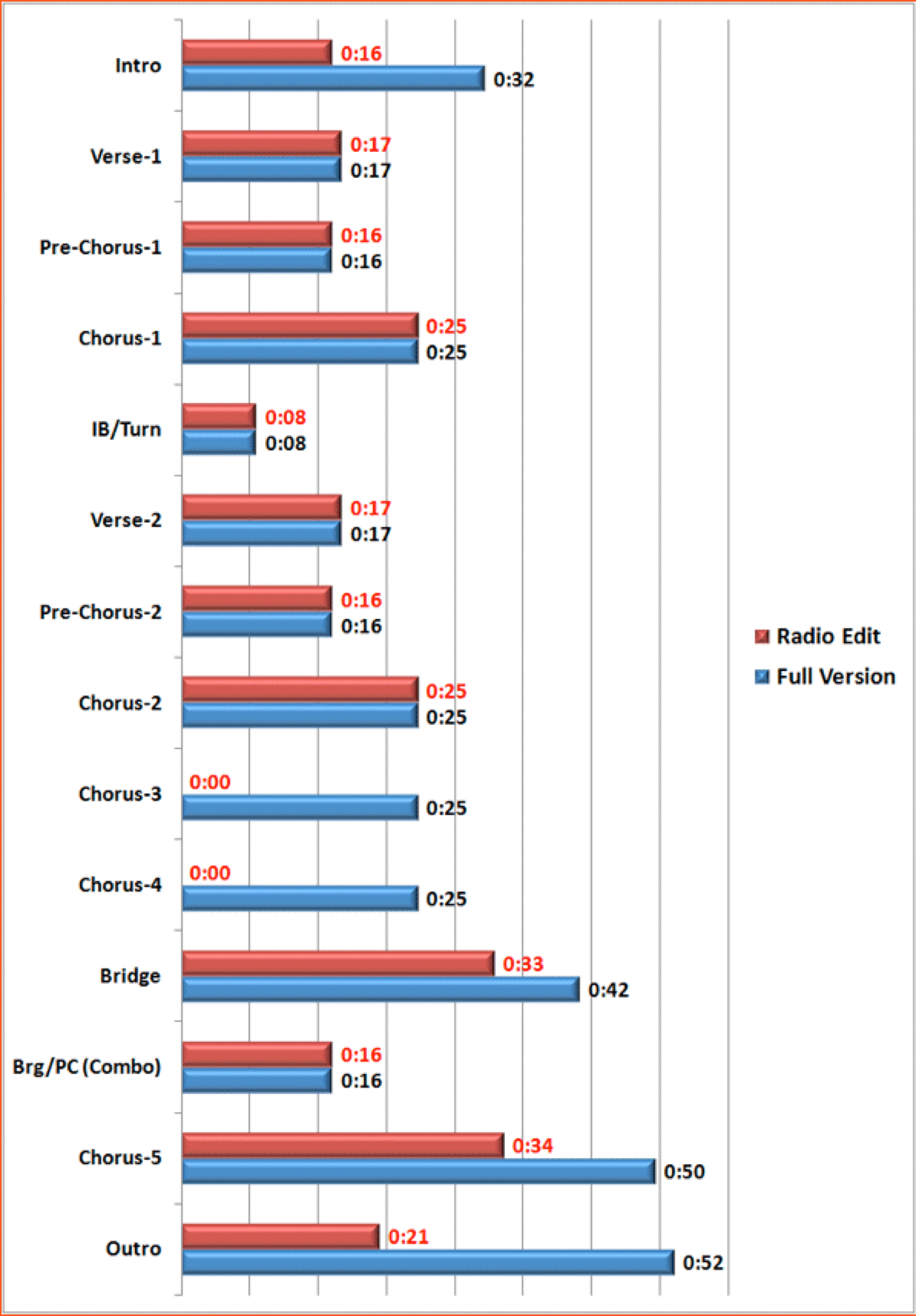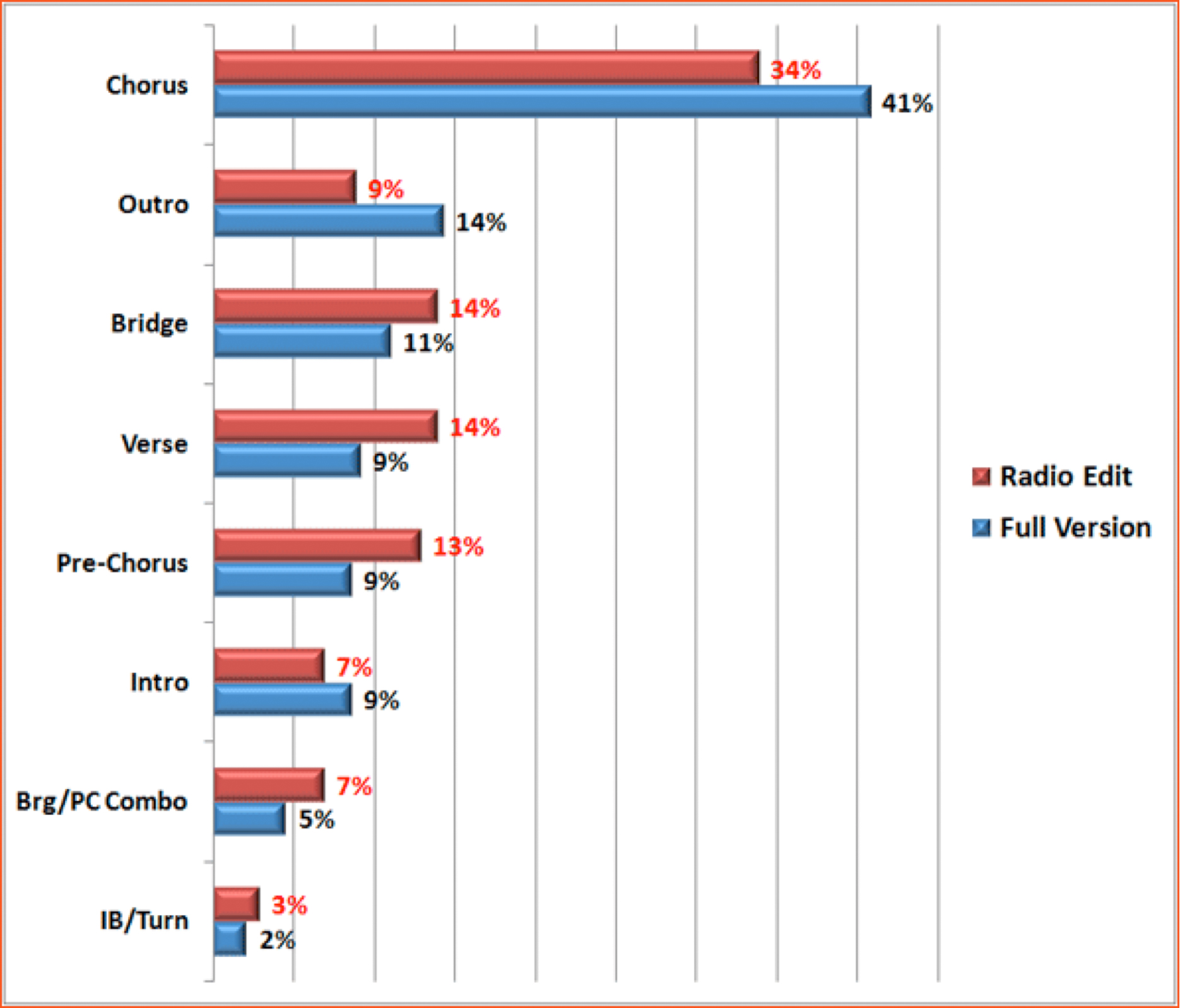Get Lucky is a global hit anomaly. How many people would have ever thought that a retro Disco/Funk/R&B song that feels like it was plucked right out of the 1970′s could top the charts in 2013 and become one of the feel good hits of the summer?
Not many.
But when you take into account various factors including the retro vibe that has permeated the current mainstream, the return of Daft Punk in reinvented form, the collaboration with veteran hitmaker Nile Rodgers’, the vocal talent of Pharrell Williams, exceptional craft and a vibe that connects on a “human” level, all things are possible.
To date Get Lucky has hit #1 on 25 charts and landed in the top 10 in 34 countries.
In this article we’re going to take a look at how Get Lucky’s radio edit transformed it from a lengthy 6:06 down to a lean 4:04, priming it for success in an airplay environment.
Anatomy of a Radio Edit
Form Transformation
Get Lucky’s form was trimmed down from a chorus heavy A-B-A-B-B-B-C-B to a leaner A-B-A-B-C-B (Verse – Chorus – Verse – Chorus – Bridge – Chorus), which is indicative of the vast majority of chart-topping Pop hits.
Sectional Modification
The following modifications to Get Lucky’s structure were employed to achieve the radio edit:
- Certain sections were cut down in length
- Certain sections were done away with all together
- Certain sections were combined with one another to form a “hybrid” section

The Edits
*In Line With The Non-Edit Version – Verse 1 through Pre-Chorus 2
Notice that the first 7 sections of the radio edit (intro – verse 1 – pre-chorus 1 – chorus – IB/Turn – Verse 2 – pre-chorus 2) were left as is EXCEPT for the intro.
Edit #1 – The Intro (Removes 0:16 from the song)
The intro was cut down from an exceptionally long 0:32 to a much more engaging and digestible 0:16, which is just 0:05 longer than the 0:11 top 10 Pop song average. At this length it doesn’t wear out its welcome with the listener, and result in their attention starting to wander.
Edit #2 – Chorus 2 (Sectional time remains the same)
The first 0:09 from the original “full band” chorus 2 section was fused together with the 0:16 partial breakdown that defines chorus 3 in the full version of the song.
By combining both the “full band” and breakdown choruses into 1, they were able to maximize the engagement value for the listener as opposed to sticking with 1 primary theme throughout.
Edit #3 – Chorus 3 & 4 (Removes 0:50 from the song)
These full chorus sections were completely scratched from the song.
Edit #4 – Bridge (Removes 0:09 from the song)
In order to cut down on the time of the bridge but still give the listener all that was included in the full version, the “we’re up all night to get” first part of the bridge was given only 1 go-around instead of the 2 that defined the full version of the song (which was actually quite monotonous).
*In-Line With The Non-Edit Version – The Pre-Chorus/Bridge Combo Section
Directly following the bridge, this section remained the same as the non-edit version of the song.
Edit #5 – Chorus 5 (Removes 0:16 from the song)
Initially, the non-edit and radio edit versions of the song are identical for the first 0:33 of the section. From that point on, the non-edit version precedes into a breakdown chorus before heading into the outro, while the radio edit version forgoes the breakdown and immediately goes into the outro.
Edit #6 – Outro (Removes 0:31 from the song)
The radio edit version of the outro begins 0:16 into the non-edited version – where that “funky” synth line enters the mix. This is then repeated 4 times in the full version before fading out in comparison to being repeated just 3 times in the radio edit version.
Adjusted Sectional Weight Within The Song

Conclusion
Get Lucky’s radio edit shaved 2:02 from the song and kept the flow intact, providing the listener with all of the highlights from the original version, but in streamlined form.
As a songwriter, use Get Lucky as a reference for your own edits, and be sure to check out other songs in different genres to see what other types of methods are utilized. Not only will this help you when it comes time to edit your own song, but it will also help you during the initial composition process where you’ll instinctively craft your song to include “edit points” which will make the edit much easier to do when the time comes. This is also the case in regard to film and TV music as well.
